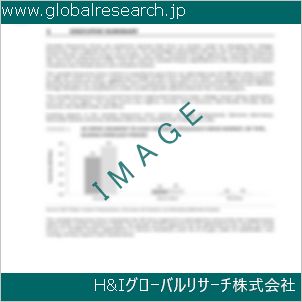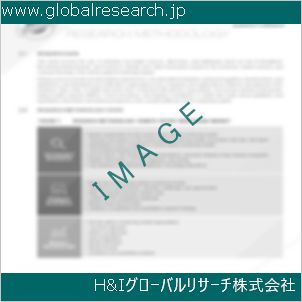1 ブチルレゾルシノール市場概要
1.1 製品定義
1.2 タイプ別ブチルレゾルシノール
1.2.1 タイプ別世界ブチルレゾルシノール市場規模成長率分析
1.2.2 タイプ 1
1.2.3 タイプ 2
1.2.4 …
… …
1.3 用途別ブチルレゾルシノール
1.3.1 用途別世界ブチルレゾルシノール市場規模成長率分析
1.3.2 用途 1
1.3.3 用途 2
1.3.4 …
… …
1.4 世界市場の成長見通し
1.4.1 世界ブチルレゾルシノール生産額の推定と予測
1.4.2 世界ブチルレゾルシノール生産能力の推定と予測
1.4.3 世界ブチルレゾルシノール生産量の推定と予測
1.4.4 世界ブチルレゾルシノール市場平均価格の推定と予測
1.5 前提条件と制限事項
2 メーカー別市場競争
2.1 メーカー別世界ブチルレゾルシノール生産市場シェア
2.2 メーカー別世界ブチルレゾルシノール生産額市場シェア
2.3 世界のブチルレゾルシノール主要プレーヤー、業界ランキング
2.4 世界の企業タイプおよび企業タイプ別市場シェア(Tier 1、Tier 2、および Tier 3)
2.5 メーカー別世界ブチルレゾルシノール平均価格
2.6 世界のブチルレゾルシノール主要メーカー、製造拠点分布および本社
2.7 世界のブチルレゾルシノール主要メーカー、提供製品および用途
2.8 世界のブチルレゾルシノール主要メーカー、本業界への参入時期
2.9 ブチルレゾルシノール市場競争状況と動向
2.9.1 ブチルレゾルシノール市場集中度
2.9.2 世界のブチルレゾルシノールプレーヤー売上高別市場シェア 上位5社および上位10社
2.10 合併・買収、事業拡大
3 地域別ブチルレゾルシノール生産
3.1 地域別世界ブチルレゾルシノール生産額の推定と予測
3.2 地域別世界ブチルレゾルシノール生産額
3.2.1 地域別世界ブチルレゾルシノール生産額
3.2.2 地域別世界ブチルレゾルシノール生産額予測
3.3 地域別世界ブチルレゾルシノール生産量の推定と予測
3.4 地域別世界ブチルレゾルシノール生産量
3.4.1 地域別世界ブチルレゾルシノール生産量
3.4.2 地域別世界ブチルレゾルシノール生産量予測
3.5 地域別世界ブチルレゾルシノール市場価格分析
3.6 世界ブチルレゾルシノール生産量および生産額、前年比成長率
3.6.1 北米ブチルレゾルシノール生産額の推定と予測
3.6.2 欧州ブチルレゾルシノール生産額の推定と予測
3.6.3 中国ブチルレゾルシノール生産額の推定と予測
3.6.4 日本ブチルレゾルシノール生産額の推定と予測
4 地域別ブチルレゾルシノール消費
4.1 地域別世界ブチルレゾルシノール消費量の推定と予測
4.2 地域別世界ブチルレゾルシノール消費量
4.2.1 地域別世界ブチルレゾルシノール消費量
4.2.2 地域別世界ブチルレゾルシノール消費量予測
4.3 北米
4.3.1 国別北米ブチルレゾルシノール消費成長率
4.3.2 国別北米ブチルレゾルシノール消費量
4.3.3 米国
4.3.4 カナダ
4.4 欧州
4.4.1 国別欧州ブチルレゾルシノール消費成長率
4.4.2 国別欧州ブチルレゾルシノール消費量
4.4.3 ドイツ
4.4.4 フランス
4.4.5 英国
4.4.6 イタリア
4.4.7 ロシア
4.5 アジア太平洋
4.5.1 地域別アジア太平洋ブチルレゾルシノール消費成長率
4.5.2 地域別アジア太平洋ブチルレゾルシノール消費量
4.5.3 中国
4.5.4 日本
4.5.5 韓国
4.5.6 台湾(中国)
4.5.7 東南アジア
4.5.8 インド
4.6 ラテンアメリカ、中東・アフリカ
4.6.1 国別ラテンアメリカ、中東・アフリカブチルレゾルシノール消費成長率
4.6.2 国別ラテンアメリカ、中東・アフリカブチルレゾルシノール消費量
4.6.3 メキシコ
4.6.4 ブラジル
4.6.5 トルコ
4.6.6 GCC諸国
5 タイプ別セグメント
5.1 タイプ別世界ブチルレゾルシノール生産量
5.1.1 タイプ別世界ブチルレゾルシノール生産量
5.1.2 タイプ別世界ブチルレゾルシノール生産量
5.1.3 タイプ別世界ブチルレゾルシノール生産市場シェア
5.2 タイプ別世界ブチルレゾルシノール生産額
5.2.1 タイプ別世界ブチルレゾルシノール生産額
5.2.2 タイプ別世界ブチルレゾルシノール生産額
5.2.3 タイプ別世界ブチルレゾルシノール生産額市場シェア
5.3 タイプ別世界ブチルレゾルシノール価格
6 用途別セグメント
6.1 用途別世界ブチルレゾルシノール生産量
6.1.1 用途別世界ブチルレゾルシノール生産量
6.1.2 用途別世界ブチルレゾルシノール生産量
6.1.3 用途別世界ブチルレゾルシノール生産市場シェア
6.2 用途別世界ブチルレゾルシノール生産額
6.2.1 用途別世界ブチルレゾルシノール生産額
6.2.2 用途別世界ブチルレゾルシノール生産額
6.2.3 用途別世界ブチルレゾルシノール生産額市場シェア
6.3 用途別世界ブチルレゾルシノール価格
7 主要企業の情報
7.1 企業 A
7.1.1 企業 A 企業情報
7.1.2 企業 A ブチルレゾルシノール製品ポートフォリオ
7.1.3 企業 A ブチルレゾルシノール生産、生産額、価格、粗利益率
7.1.4 企業 A 主な事業と提供市場
7.1.5 企業 A 最近の動向/最新情報
7.2 企業 B
7.2.1 企業 B 企業情報
7.2.2 企業 B ブチルレゾルシノール製品ポートフォリオ
7.2.3 企業 B ブチルレゾルシノール生産、生産額、価格、粗利益率
7.2.4 企業 B 主な事業と提供市場
7.2.5 企業 B 最近の動向/最新情報
7.3 企業 C
7.3.1 企業 C 企業情報
7.3.2 企業 C ブチルレゾルシノール製品ポートフォリオ
7.3.3 企業 C ブチルレゾルシノール生産、生産額、価格、粗利益率
7.3.4 企業 C 主な事業と提供市場
7.3.5 企業 C 最近の動向/最新情報
7.4 企業 D
7.4.1 企業 D 企業情報
7.4.2 企業 D ブチルレゾルシノール製品ポートフォリオ
7.4.3 企業 D ブチルレゾルシノール生産、生産額、価格、粗利益率
7.4.4 企業 D 主な事業と提供市場
7.4.5 企業 D 最近の動向/最新情報
7.5 企業 E
7.5.1 企業 E 企業情報
7.5.2 企業 E ブチルレゾルシノール製品ポートフォリオ
7.5.3 企業 E ブチルレゾルシノール生産、生産額、価格、粗利益率
7.5.4 企業 E 主な事業と提供市場
7.5.5 企業 E 最近の動向/最新情報
7.6 …
… …
… …
8 業界チェーンおよび販売チャネル分析
8.1 ブチルレゾルシノール業界チェーン分析
8.2 ブチルレゾルシノール原材料供給分析
8.2.1 主要原材料
8.2.2 原材料の主要サプライヤー
8.3 ブチルレゾルシノール生産モードおよびプロセス分析
8.4 ブチルレゾルシノール販売およびマーケティング
8.4.1 ブチルレゾルシノール販売チャネル
8.4.2 ブチルレゾルシノール販売代理店
8.5 ブチルレゾルシノール顧客分析
9 ブチルレゾルシノール市場ダイナミクス
9.1 ブチルレゾルシノール業界トレンド
9.2 ブチルレゾルシノール市場の促進要因
9.3 ブチルレゾルシノール市場の課題
9.4 ブチルレゾルシノール市場の阻害要因
10 調査結果および結論
11 方法論およびデータソース
11.1 方法論/調査アプローチ
11.1.1 調査プログラム/設計
11.1.2 市場規模の推定
11.1.3 市場内訳およびデータの三角測量
11.2 データソース
11.2.1 二次情報源
11.2.2 一次情報源
11.3 著者リスト
11.4 免責事項
1 Butylresorcinol Market Overview
1.1 Product Definition
1.2 Butylresorcinol by Type
1.2.1 Global Butylresorcinol Market Value Growth Rate Analysis by Type
1.2.2 Type 1
1.2.3 Type 2
1.2.4 ...
... ...
1.3 Butylresorcinol by Application
1.3.1 Global Butylresorcinol Market Value Growth Rate Analysis by Application
1.3.2 Application 1
1.3.3 Application 2
1.3.4 ...
... ...
1.4 Global Market Growth Prospects
1.4.1 Global Butylresorcinol Production Value Estimates and Forecasts
1.4.2 Global Butylresorcinol Production Capacity Estimates and Forecasts
1.4.3 Global Butylresorcinol Production Estimates and Forecasts
1.4.4 Global Butylresorcinol Market Average Price Estimates and Forecasts
1.5 Assumptions and Limitations
2 Market Competition by Manufacturers
2.1 Global Butylresorcinol Production Market Share by Manufacturers
2.2 Global Butylresorcinol Production Value Market Share by Manufacturers
2.3 Global Key Players of Butylresorcinol, Industry Ranking
2.4 Global Butylresorcinol Company Type and Market Share by Company Type (Tier 1, Tier 2, and Tier 3)
2.5 Global Butylresorcinol Average Price by Manufacturers
2.6 Global Key Manufacturers of Butylresorcinol, Manufacturing Base Distribution and Headquarters
2.7 Global Key Manufacturers of Butylresorcinol, Product Offered and Application
2.8 Global Key Manufacturers of Butylresorcinol, Date of Enter into This Industry
2.9 Butylresorcinol Market Competitive Situation and Trends
2.9.1 Butylresorcinol Market Concentration Rate
2.9.2 Global 5 and 10 Largest Butylresorcinol Players Market Share by Revenue
2.10 Mergers & Acquisitions, Expansion
3 Butylresorcinol Production by Region
3.1 Global Butylresorcinol Production Value Estimates and Forecasts by Region
3.2 Global Butylresorcinol Production Value by Region
3.2.1 Global Butylresorcinol Production Value by Region
3.2.2 Global Forecasted Production Value of Butylresorcinol by Region
3.3 Global Butylresorcinol Production Estimates and Forecasts by Region
3.4 Global Butylresorcinol Production Volume by Region
3.4.1 Global Butylresorcinol Production by Region
3.4.2 Global Forecasted Production of Butylresorcinol by Region
3.5 Global Butylresorcinol Market Price Analysis by Region
3.6 Global Butylresorcinol Production and Value, Year-over-Year Growth
3.6.1 North America Butylresorcinol Production Value Estimates and Forecasts
3.6.2 Europe Butylresorcinol Production Value Estimates and Forecasts
3.6.3 China Butylresorcinol Production Value Estimates and Forecasts
3.6.4 Japan Butylresorcinol Production Value Estimates and Forecasts
4 Butylresorcinol Consumption by Region
4.1 Global Butylresorcinol Consumption Estimates and Forecasts by Region
4.2 Global Butylresorcinol Consumption by Region
4.2.1 Global Butylresorcinol Consumption by Region
4.2.2 Global Butylresorcinol Forecasted Consumption by Region
4.3 North America
4.3.1 North America Butylresorcinol Consumption Growth Rate by Country
4.3.2 North America Butylresorcinol Consumption by Country
4.3.3 U.S.
4.3.4 Canada
4.4 Europe
4.4.1 Europe Butylresorcinol Consumption Growth Rate by Country
4.4.2 Europe Butylresorcinol Consumption by Country
4.4.3 Germany
4.4.4 France
4.4.5 U.K.
4.4.6 Italy
4.4.7 Russia
4.5 Asia Pacific
4.5.1 Asia Pacific Butylresorcinol Consumption Growth Rate by Region
4.5.2 Asia Pacific Butylresorcinol Consumption by Region
4.5.3 China
4.5.4 Japan
4.5.5 South Korea
4.5.6 China Taiwan
4.5.7 Southeast Asia
4.5.8 India
4.6 Latin America, Middle East & Africa
4.6.1 Latin America, Middle East & Africa Butylresorcinol Consumption Growth Rate by Country
4.6.2 Latin America, Middle East & Africa Butylresorcinol Consumption by Country
4.6.3 Mexico
4.6.4 Brazil
4.6.5 Turkey
4.6.6 GCC Countries
5 Segment by Type
5.1 Global Butylresorcinol Production by Type
5.1.1 Global Butylresorcinol Production by Type
5.1.2 Global Butylresorcinol Production by Type
5.1.3 Global Butylresorcinol Production Market Share by Type
5.2 Global Butylresorcinol Production Value by Type
5.2.1 Global Butylresorcinol Production Value by Type
5.2.2 Global Butylresorcinol Production Value by Type
5.2.3 Global Butylresorcinol Production Value Market Share by Type
5.3 Global Butylresorcinol Price by Type
6 Segment by Application
6.1 Global Butylresorcinol Production by Application
6.1.1 Global Butylresorcinol Production by Application
6.1.2 Global Butylresorcinol Production by Application
6.1.3 Global Butylresorcinol Production Market Share by Application
6.2 Global Butylresorcinol Production Value by Application
6.2.1 Global Butylresorcinol Production Value by Application
6.2.2 Global Butylresorcinol Production Value by Application
6.2.3 Global Butylresorcinol Production Value Market Share by Application
6.3 Global Butylresorcinol Price by Application
7 Key Companies Profiled
7.1 Company A
7.1.1 Company A Butylresorcinol Company Information
7.1.2 Company A Butylresorcinol Product Portfolio
7.1.3 Company A Butylresorcinol Production, Value, Price and Gross Margin
7.1.4 Company A Main Business and Markets Served
7.1.5 Company A Recent Developments/Updates
7.2 Company B
7.2.1 Company B Butylresorcinol Company Information
7.2.2 Company B Butylresorcinol Product Portfolio
7.2.3 Company B Butylresorcinol Production, Value, Price and Gross Margin
7.2.4 Company B Main Business and Markets Served
7.2.5 Company B Recent Developments/Updates
7.3 Company C
7.3.1 Company C Butylresorcinol Company Information
7.3.2 Company C Butylresorcinol Product Portfolio
7.3.3 Company C Butylresorcinol Production, Value, Price and Gross Margin
7.3.4 Company C Main Business and Markets Served
7.3.5 Company C Recent Developments/Updates
7.4 Company D
7.4.1 Company D Butylresorcinol Company Information
7.4.2 Company D Butylresorcinol Product Portfolio
7.4.3 Company D Butylresorcinol Production, Value, Price and Gross Margin
7.4.4 Company D Main Business and Markets Served
7.4.5 Company D Recent Developments/Updates
7.5 Company E
7.5.1 Company E Butylresorcinol Company Information
7.5.2 Company E Butylresorcinol Product Portfolio
7.5.3 Company E Butylresorcinol Production, Value, Price and Gross Margin
7.5.4 Company E Main Business and Markets Served
7.5.5 Company E Recent Developments/Updates
7.6 ...
... ...
... ...
8 Industry Chain and Sales Channels Analysis
8.1 Butylresorcinol Industry Chain Analysis
8.2 Butylresorcinol Raw Material Supply Analysis
8.2.1 Key Raw Materials
8.2.2 Raw Materials Key Suppliers
8.3 Butylresorcinol Production Mode & Process Analysis
8.4 Butylresorcinol Sales and Marketing
8.4.1 Butylresorcinol Sales Channels
8.4.2 Butylresorcinol Distributors
8.5 Butylresorcinol Customer Analysis
9 Butylresorcinol Market Dynamics
9.1 Butylresorcinol Industry Trends
9.2 Butylresorcinol Market Drivers
9.3 Butylresorcinol Market Challenges
9.4 Butylresorcinol Market Restraints
10 Research Findings and Conclusion
11 Methodology and Data Source
11.1 Methodology/Research Approach
11.1.1 Research Programs/Design
11.1.2 Market Size Estimation
11.1.3 Market Breakdown and Data Triangulation
11.2 Data Source
11.2.1 Secondary Sources
11.2.2 Primary Sources
11.3 Author List
11.4 Disclaimer
| ※参考情報 ブチルレゾルシノールは、化学構造としては二価のフェノール類に属する化合物で、主にスキンケア製品や化粧品に使用される成分です。CAS番号は18979-61-8であり、近年では美白作用や抗酸化作用が注目されています。本稿では、ブチルレゾルシノールの定義、特徴、用途、関連技術について詳しく説明いたします。 まず、ブチルレゾルシノールの化学構造について触れましょう。ブチルレゾルシノールは、レゾルシノールの誘導体であり、分子内にブチル基を持つことで脂溶性が増し、皮膚への浸透性が高まる特徴があります。この性質は、スキンケア製品に含まれる際に、肌に良い効果をもたらすための重要な要素となっています。 ブチルレゾルシノールの主な特徴のひとつは、その美白効果です。皮膚のメラニン生成を抑制する作用があり、肌の色むらやシミを改善するための成分として広く使用されています。具体的には、チロシナーゼという酵素の活性を抑え、メラニン合成を阻害することによって、肌のトーンを均一に保つ手助けをします。そのため、ブチルレゾルシノールは、漂白剤としての作用を持つため、特に美白を目的とした製品において非常に重要な成分とされています。 さらに、ブチルレゾルシノールには抗酸化作用もあります。肌の老化を引き起こす原因の一つが酸化ストレスであり、このストレスに対処するためには抗酸化物質が必須です。ブチルレゾルシノールは、フリーラジカルの生成を抑制し、細胞のダメージを防ぐ役割を果たします。このため、エイジングケア製品にも多く使用されています。 用途としては、主にスキンケア製品や化粧品に使われており、特に美白クリーム、ローション、セラム、日焼け止めなどで見かけることが多いです。また、メイクアップ製品やファンデーションの中にも配合されることがあります。これにより、塗布した瞬間から美白作用が期待できるほか、肌表面をなめらかに整え、化粧のノリを良くする効果もあるとされています。 ブチルレゾルシノールはその特性から、他の成分と組み合わせて使用されることも多く、相乗効果を生み出すことが期待されます。例えば、ビタミンCやハイアロン酸などの保湿成分と併用することで、美白効果がさらに高まる可能性があります。このように、複数の有効成分を組み合わせることによって、より効果的なスキンケア製品が開発されています。 ブチルレゾルシノールは、一般的には皮膚に対する安全性が高いとされていますが、個人の肌の状態や製品に含まれる他の成分との相互作用によっては、アレルギー反応を引き起こす可能性もあります。そのため、使用する前にはパッチテストを行うことが推奨されます。 さらに、ブチルレゾルシノールの製造方法についても触れておく必要があります。一般には化学的合成によって製造されますが、近年ではより環境に配慮した製造プロセスが求められています。エコフレンドリーな合成経路の開発や、リサイクル可能な材料の使用が進められ、持続可能な社会に貢献するための取り組みが続いています。 関連技術としては、他の美白成分や抗酸化成分と組み合わせる技術が挙げられます。特に、ナノテクノロジーの進展により、ブチルレゾルシノールをナノ粒子化することで、より効率的な浸透を実現し、効果的なスキンケアを提供することが可能になっています。また、ブチルレゾルシノールの活性を高めるための新たなキャリア剤の開発も、今後の技術革新において重要なテーマとなるでしょう。 結論として、ブチルレゾルシノールは美白や抗酸化作用を持つ有効成分として、多岐にわたるスキンケア製品に応用されている重要な化合物です。その特性はさまざまな製品で活かされ、化粧品業界において今後もますます注目される存在となることでしょう。持続可能な開発と安全性の確保が求められる中、ブチルレゾルシノールの利用はより一層進化していくと期待されています。 |
❖ 免責事項 ❖
http://www.globalresearch.jp/disclaimer












